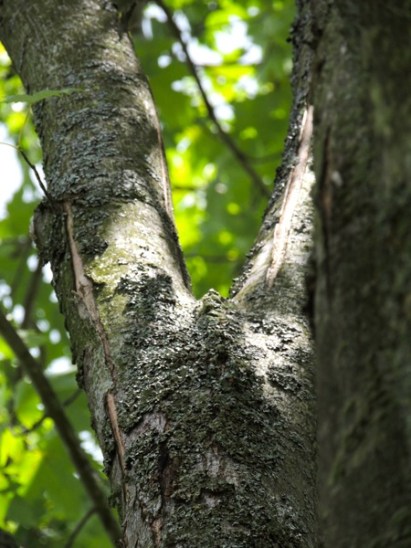
There is always music amongst the trees in the garden,
but our hearts must be very quiet to hear it.
Minnie Aumonier
Just wanted you to know that both blogs are experiencing a few glitches since we moved them to a new host server. Things should smooth out soon, but you may find a comment is missing or you cannot access the blog. I appreciate your patience as things work themselves out. Now on to the post….
In my last tree following post, I mentioned my fascination and curiosity regarding the lichen that grows so heavily on my maple tree. Some folks speculated about the lichen, and I thought I would dig into the story behind lichen a bit more to bring its story to light.
I am linking in with Lucy@Loose and Leafy’s Tree Following meme that happens around the 7th of every month.
The tree, now fully leafed out, is providing lovely shade for us and shelter for many birds who are still frequenting the garden especially the wrens who are raising a second brood nearby.
Lichen is formed from a unique relationship between fungus and algae. Fungus gives protection and support, and algae provides food for photosynthesis.
Lichens can be found in land or aquatic areas all over the world. They are found particularly where there are weather extremes (much like where I live), and you usually find them on rocks and tree bark. But be careful to distinguish lichen from moss. Lichens appear dry, thin and coarse. You can see both in the growing down from the crook of the tree with moss being a dark green growing down the center.
A great many lichen species are found in undisturbed habitats such as ancient forests. And since lichens are vulnerable to changes in the habitat scientists use lichens to target areas that should be protected. It is also said that lichens cannot grow in areas with heavy pollution.
You can find thousands of lichens throughout the US and Canada and well over 2500 have been found in the National Parks where habitats are less disturbed.
To figure out which lichen you may have you have to look first at the surface texture which can be granular, smooth or veined. Then look at color which can vary from white, grey, orange, reds, yellow-greens and greens. I have gray, green and orange lichens that appear smooth. The last thing to look for are what are called lobules. These are growths coming out from the lichen that are used in the lichen’s reproductive process.
Determining which type of lichen you may have can be difficult and may require an expert. But most experts say that you will generally find three types of lichen in most backyards: Crustose, Foliose and Fruticose.
Mine appear to be mostly of the Foliose variety. Foliose is so named because this lichen looks like foliage or leaves. As this lichen ages the edges will curl up. It appears my lichen is quite old in spots as it is curling up in the picture above and below.
 Lichens have a been used by wildlife and people for centuries.
Lichens have a been used by wildlife and people for centuries.
In particular native people have used lichens to dye yarn and fabric. There is one specific lichen used for its antibacterial and antifungal properties in some countries, and here in the U.S. it is used in perfumes, toothpaste and natural deodorant sticks.
Lichens are used extensively by wildlife because of their ability to retain water. They serve as a refuge from predators for some amphibians and insects, who also lay eggs in lichen.
Many species of birds in North America use lichens. Some like grouse and wild turkey eat lichen. Others like Warblers, Vireos and hummingbirds use lichens in their nests.
There are mammals who also eat lichen like mountain goats in Alaska, and flying squirrels like to use lichen in their nests too.
Do you notice lots of lichen on your trees? What does it look like?
Trees embellish a landscape and a garden. Even in small places where size is restricted, the mere presence of just one tree…instantly adds a serious dimension to the overall effect… ~Mirabel Osler
______________________________________________________________________________
Visit my new blog:
I wanted to thank all the wonderful people who visited me last Thursday and this past Sunday as I continued to post at my new blog, Living From Happiness. It is a blog to celebrate life, lessons, change, challenges and creativity.
I do hope you will join me there.
There will be a new post tomorrow.
______________________________________________________________________________
Next up on the blog: Monday brings another Garden Blogger’s Bloom Day, and Wednesday I will have an update on the veg garden.
All original content is copyrighted and the sole property of Donna Donabella @ Gardens Eye View, 2010-2014. Any reprints or use of content or photos is by permission only.






